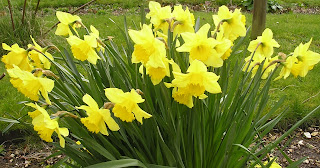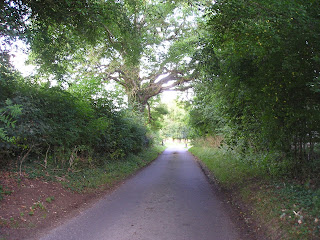Finally, We Have Daffodils!
Despite a return to cold, blustery weather and barely a decent spring day so far this year, the daffodils (narcissus) have at last started to bloom.
I suppose it is because of the long winter weeks of relative stillness in the garden that we eagerly await the first signs of new life: the first grey green tip of the daffodil’s leaves pushing through the soil, the lengthening of the flower stalk, the swelling of the bud and the first hint of colour and, then, the pleasure of seeing the open trumpet in all its glory. And how apt that daffodils are one of the few flowers that have trumpets, for the sight of them, whether just a few or en masse, herald the start of the floral year with a fanfare of pleasure as great as any orchestral masterpiece.
I suppose it is because of the long winter weeks of relative stillness in the garden that we eagerly await the first signs of new life: the first grey green tip of the daffodil’s leaves pushing through the soil, the lengthening of the flower stalk, the swelling of the bud and the first hint of colour and, then, the pleasure of seeing the open trumpet in all its glory. And how apt that daffodils are one of the few flowers that have trumpets, for the sight of them, whether just a few or en masse, herald the start of the floral year with a fanfare of pleasure as great as any orchestral masterpiece.
Last autumn saw the planting of 8000 daffodils along the edge of a field that led to one of our client’s houses. The hard labour was well worthwhile both in physical effort and the time we have had to wait to see the result. When I plant like this, I mix the varieties to extend the flowering period – generally Carlton, St Keverne, Counsellor and, if I want a few white included, Ice Follies.

Combination of varieties to extend the flowering period

Narcissus 'Ice Follies'
I can be incredibly opinionated, as many of you will know, where plants are concerned. I tend to prefer simple, unimproved varieties – fancy colours and doubles, or those described as having the largest flowers ever seen, can be left for others to grow. I can see no reason why, for example, a bloom “as big as your face” (as I saw one begonia described) is considered desirable. I am not keen on double daffodils as they nearly always seem to be top heavy. The slightest puff of wind or shower of snow and the heads sit face down on the ground where they remain to be eaten by slugs. Ice King is a variety I plant – although hardly to be described as a favourite – as it stands fairly well. In the photo one bloom has collapsed which rather proves a point.
Salome, is a bi coloured variety, the trumpet changing from a rich yellow to a peachy shade as it fades. I can never decide if I really like it or not. Here, in the photo below, it gives a warm glow to the border. However, what can be more charming the pure simplicity of Segovia? Its delicate yellow cup and pure white, evenly spaced petals (or perianth, if we want to be horticulturally correct) give it the look of a plant that has quiet superiority.

Narcissus 'Segovia'
Whatever your personal preference, daffodils are a joy and amazing value for money. With individual bulbs just costing pence each and increasing year by year if left to naturalise, it is always remarkable that after a few short weeks, we cannot wait to see them gone, being tired of their gently decaying leaves which interfere with our border work or mowing regimes.
.
When grown in grass, we mow the top growth off six weeks after flowering for, by then, nourishment has returned to the bulb and next years flowering is assured. Just to be doubly certain, we feed the grass grown bulbs with Autumn lawn food (minus the weedkiller, of course) immediately after flowering. And being the fickle species man is, six months later we will be back eagerly scouring the ground for the first signs of the daffodils and the forthcoming warmer weather once more.






Love the Daffs, everyone of them....your post is well written as well.
ReplyDelete8,000 daffs, what a show that is.
ReplyDeleteThe drifts of daffodils on the edge of the field is a stunning sight ... so worth the effort!
ReplyDeleteThanks, Darla, for the compliment, very kind.
ReplyDeleteThanks, too, Kilbourne & Bernie - they are rather spectacular, aren't they? Pity they aren't in my garden although there wouldn't be enough room anyway!
Johnson
Do you count them every year? They look awesome! Nice pics and post. jim
ReplyDeleteDelightful post by someone who clearly knows Narcissus!
ReplyDeleteInteresting to see the different cultivars. I have to admit that I avoid the doubles for the same reason. Even the singles started toppling over in the rain yesterday.
ReplyDeleteI do tend to agree with you re some cultivars. I dislike double daffodils, begonias, etc as I have read they have little to offer our bees and insects. I much prefer the smaller daffodils, our older large ones often fall in the rain. Really interesting post, thank you Johnson.
ReplyDeleteDear Johnson, I do so love the mass plantings of daffodils and, like you, much prefer the unimproved varieties. I think your swathe of them alongside the client's driveway is particularly effective - you must be very pleased with the way it has worked out [despite the effort of planting 8000!].
ReplyDeleteI wonder if you know of the fields of wild daffodils to be found near to Dymock on the Herefordshire/Gloucestershire borders?
Johnson, I too like the simplicity of the Narcissus 'Ice Follies' and 'Burma' - elegant and stands by itself, and do love your large planting of daffodils. Not far from our home is the annual Daffodil Festival (recently occurred) - four miles of a daffodil-lined delight; one cannot help but smile and know that Spring is here. Happy Spring to you!
ReplyDeleteThanks to all of you for your comments.
ReplyDeleteEdith - I know the wild daffodils of Dymock extremely well. I have a great friend that lives nearby and kept my horses with her for a while. Riding through the woods at daffodil time was an absolute joy. I had hoped to get down there this year to geta photo for this post but no time unfortunately.
Johnson
I am curious as to what would happen if they saw themselves in mirror. Would they freeze like their progenitor, transfixed by their own exquisite beauty?
ReplyDelete